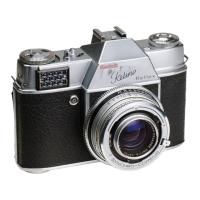FOR TIME EXPOSURES turn the shutter setting ring to bring the letter B (=brief time) opposite the arrow head.
On pressing the release, the shutter will remain open as long as the release is pressed down, and closes as
soon as the pressure on the released is removed.
The green figures on the exposure scale are time exposures. They indicate the time in seconds for which the
release has to be depressed at some of the smaller apertures at low lighting levels. If, for example, an exposure
setting gives 1 sec. at f2.8 any of the following combinations may be used: 4 sec. at f5.6; 8 sec. at f8; 15 sec.
at f11; or 30 sec. at f16. Incidentally, there is no green number 2. Its place is taken up by B. When reading off
full seconds, read 2 seconds for the B position. In the example above, if you want to use f4, you would require 2
seconds.
THE DELAYED-ACTION RELEASE for self-portraits, built into the shutter, is brought into action by moving
upwards the green lever on the shutter beside the release key.
On pressing the release button with the lever set to "V", the shutter goes off after a delay of approximately 10
sec., giving the operator time to take his place in the picture. Once the lever has been set to "V", it cannot be
moved again. On releasing, the lever will automatically spring back into the original position.
FLASH. The Retina Reflex IV has a fixed X flash synchronization. Therefore only those instructions on page 60
referring to X-synchronization apply.
THE RETINA REFLEX III
THE RETINA REFLEX III is fitted with a 2-in. (50 mm.) Retina Xenar or Retina-Ysarex f2.8 or a 2 in. (50 mm.)
Retina-Xenon or Retina-Heligon f1.9. The f2.8 lenses are four-element triplets, the f1.9 lenses have six
elements of symmetrical four-component design. All have an angle of view of 47° and permit focusing from
infinity down to 3 ft.
The complete lens is interchangeable against wide-angle and tele-photo lenses. The built-in photo-electric
exposure meter is directly coupled to the aperture setting. The meter needle is set in the viewfinder without
taking the camera from the eye. The exposure meter needle is also visible in a window on top of the camera.
The extra-large eyepiece of the finder shows the entire picture on the ground glass screen even when wearing
spectacles or sunglasses.
A release key with safety button prevents unintentional exposures. The handy location of the key ensures
particularly smooth release.
The built-in Synchro-Compur shutter has cross-coupled shutter speed and aperture settings.
The f2.8 lenses accept 32 mm. screw-in filters and close-up lenses. (32 mm. is the outside diameter). The lens
hood is rectangular with a tubular bayonet fitting on the back to fit the bayonet mount surrounding the lens
itself.
The f1.9 lenses accept filters and close-up lenses of 60 mm. diameter. No lens hood is ordinarily required as the
lens is deeply recessed in its mount.
OTHER ACCESSORIES include a close-up attachment, table stand, copying stand, 1:1 close-up stand, microscope
adaptor, and framefinder.

